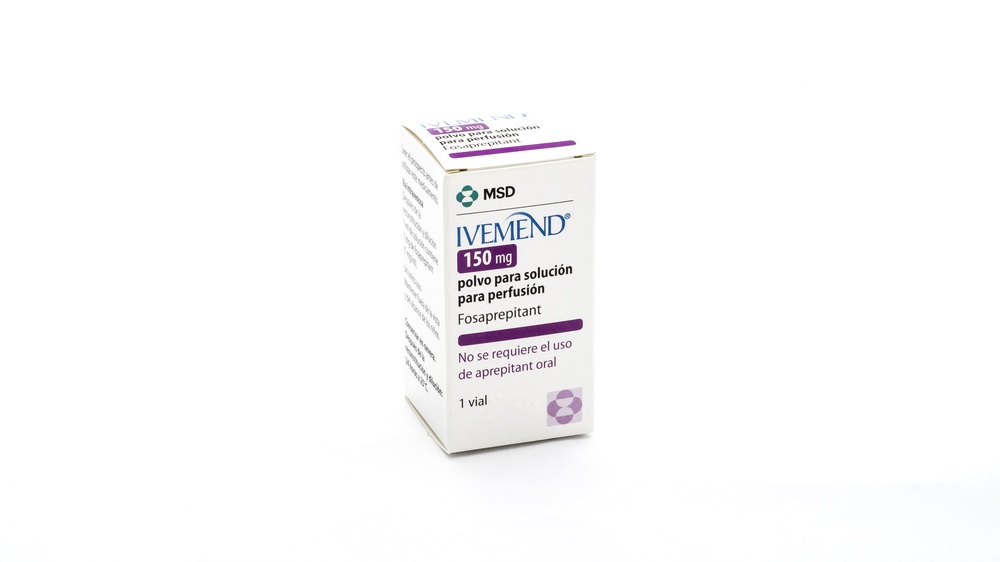

IVEMEND 150 mg POWDER FOR SOLUTION FOR INFUSION

Ask a doctor about a prescription for IVEMEND 150 mg POWDER FOR SOLUTION FOR INFUSION

How to use IVEMEND 150 mg POWDER FOR SOLUTION FOR INFUSION
Introduction
Package Leaflet: Information for the User
IVEMEND 150mg powder for solution for infusion
fosaprepitant
Read all of this leaflet carefully before you start using this medicine because it contains important information for you.
- Keep this leaflet, you may need to read it again.
- If you have any further questions, ask your doctor, pharmacist, or nurse.
- If you experience any side effects, talk to your doctor, pharmacist, or nurse, even if they are not listed in this leaflet. See section 4.
Contents of the pack
- What is IVEMEND and what is it used for
- What you need to know before you use IVEMEND
- How to use IVEMEND
- Possible side effects
- Storage of IVEMEND
- Contents of the pack and further information
1. What is IVEMEND and what is it used for
IVEMEND contains the active substance fosaprepitant, which is converted into aprepitant in your body. It belongs to a group of medicines called "neurokinin 1 (NK1) receptor antagonists". The brain has a specific area that controls nausea and vomiting. IVEMEND works by blocking the signals to this area, thereby reducing nausea and vomiting. IVEMEND is used in adults, adolescents, and children from 6 months of age, in combination with other medicines,to prevent nausea and vomiting caused by a type of chemotherapy (cancer treatment) that induces nausea and vomiting strongly or moderately.
2. What you need to know before you use IVEMEND
Do not use IVEMEND
- if you are allergic to fosaprepitant, aprepitant, or polysorbate 80 or any of the other ingredients of this medicine (listed in section 6).
- with medicines that contain pimozide (used to treat psychiatric disorders), terfenadine, and astemizole (used for allergic rhinitis and other allergic disorders), cisapride (used to treat digestive problems). Inform your doctor if you are taking these medicines, as the treatment should be modified before starting to use IVEMEND.
Warnings and precautions
Talk to your doctor, pharmacist, or nurse before you start using IVEMEND.
Before treatment with this medicine, tell your doctor if you have liver disease, because the liver is important for removing the medicine from the body. Therefore, your doctor may need to monitor your liver condition.
Children and adolescents
Do not give IVEMEND to children under 6 months of age or weighing less than 6 kg, because the use of this medicine has not been studied in this population.
Other medicines and IVEMEND
IVEMEND may affect other medicines both during and after treatment with IVEMEND. There are some medicines that should not be used with IVEMEND (such as pimozide, terfenadine, astemizole, and cisapride) or that require a dose adjustment (see also ‘Do not use IVEMEND’).
The effects of IVEMEND or other medicines may be influenced if you take IVEMEND with other medicines, including those listed below. Talk to your doctor or pharmacist if you are taking any of the following medicines:
- contraceptive medicines that may include birth control pills, skin patches, implants, and certain intrauterine devices (IUDs) that release hormones, may not work properly when taken with IVEMEND. During treatment with IVEMEND and up to 2 months after using IVEMEND, non-hormonal methods or additional methods of contraception should be used,
- cyclosporine, tacrolimus, sirolimus, everolimus (immunosuppressants),
- alfentanil, fentanyl (used to treat pain),
- quinidine (used to treat irregular heartbeats),
- irinotecan, etoposide, vinorelbine, ifosfamide (medicines used to treat cancer),
- medicines that contain ergotamine derivatives, such as ergotamine and dihydroergotamine (used to treat migraines),
- warfarin, acenocoumarol (blood thinners; blood tests may be needed),
- rifampicin, clarithromycin, telithromycin (antibiotics used to treat infections),
- phenytoin (a medicine used to treat seizures),
- carbamazepine (used to treat depression and epilepsy),
- midazolam, triazolam, phenobarbital (medicines used to calm or help sleep),
- St. John's Wort (a herbal preparation used to treat depression),
- protease inhibitors (used to treat HIV infections),
- ketoconazole, except shampoo (used to treat Cushing's syndrome - when the body produces too much cortisol),
- itraconazole, voriconazole, posaconazole (antifungals),
- nefazodone (used to treat depression),
- diltiazem (a medicine used to treat high blood pressure),
- corticosteroids (such as dexamethasone),
- anxiety medicines (such as alprazolam),
- tolbutamide (a medicine used to treat diabetes).
Tell your doctor if you are using, have recently used, or might use any other medicine or herbal remedy.
Pregnancy and breastfeeding
This medicine should not be used during pregnancy unless clearly necessary. If you are pregnant or breastfeeding, think you may be pregnant, or plan to become pregnant, consult your doctor before using this medicine.
For information related to birth control, see ‘Other medicines and IVEMEND’.
It is not known if IVEMEND passes into breast milk; therefore, breastfeeding is not recommended during treatment with this medicine. It is important to inform your doctor before receiving this medicine if you are breastfeeding or plan to breastfeed.
Driving and using machines
It should be taken into account that some people experience dizziness and drowsiness after using IVEMEND. If you feel dizzy or drowsy, avoid driving or using machines after using this medicine (see ‘Possible side effects’).
IVEMEND contains sodium
This medicine contains less than 23 mg of sodium (1 mmol) per dose; this is, essentially “sodium-free”.
3. How to use IVEMEND
In adults (from 18 years of age), the recommended dose of IVEMEND is 150 mg of fosaprepitant on day 1 (day of chemotherapy).
In children and adolescents (from 6 months to 17 years of age), the recommended dose of IVEMEND is based on the patient's age and weight. Depending on the chemotherapy received,
IVEMEND can be administered in two ways:
IVEMEND is administered only on day 1 (single-day chemotherapy)
IVEMEND is administered on days 1, 2, and 3 (chemotherapy for one or several days)
- On days 2 and 3, oral formulations of aprepitant may be prescribed instead of IVEMEND.
The powder is reconstituted and diluted before use. The infusion solution is administered by a healthcare professional, such as a doctor or nurse, by intravenous infusion (a drip) approximately 30 minutes before chemotherapy starts in adults or 60-90 minutes before chemotherapy starts in children and adolescents. Your doctor may ask you to take other medicines to prevent nausea and vomiting, including corticosteroids (such as dexamethasone) and a 5-HT3 antagonist (such as ondansetron). In case of doubt, consult your doctor or pharmacist.
4. Possible side effects
Like all medicines, this medicine can cause side effects, although not everybody gets them.
Stop taking IVEMEND and contact your doctor immediately if you notice any of the following side effects, which can be serious and require urgent medical attention:
- Hives, rash, itching, difficulty breathing or swallowing, or a severe drop in blood pressure (frequency not known, cannot be estimated from the available data): these are signs of a severe allergic reaction.
- Reactions at the infusion site or near it. The most severe infusion site reactions have occurred with a certain type of chemotherapy that can burn or blister the skin (vesicant) with side effects including pain, swelling, and redness. In some people receiving this type of chemotherapy, skin necrosis has occurred.
Other side effects that have been reported are listed below.
Common side effects (may affect up to 1 in 10 people) are:
- constipation, indigestion,
- headache,
- fatigue,
- loss of appetite,
- hiccups,
- increased levels of liver enzymes in the blood.
Uncommon side effects (may affect up to 1 in 100 people) are:
- dizziness, drowsiness,
- acne, rash,
- anxiety,
- belching, nausea, vomiting, heartburn, stomach pain, dry mouth, flatulence,
- increased need to urinate with pain or discomfort,
- weakness, general feeling of being unwell,
- flushing of the face/skin, hot flushes,
- rapid or irregular heartbeat, increased blood pressure,
- fever with increased risk of infection, decrease in red blood cells,
- pain at the injection site, redness at the injection site, itching at the injection site, inflammation of the veins at the injection site.
Rare side effects (may affect up to 1 in 1,000 people) are:
- difficulty thinking, lack of energy, altered taste,
- sensitivity of the skin to sunlight, excessive sweating, oily skin, skin ulcers, itching, Stevens-Johnson syndrome/toxic epidermal necrolysis (a rare, severe skin reaction),
- euphoria (feeling of extreme happiness), disorientation,
- bacterial infection, fungal infection,
- severe constipation, stomach ulcer, inflammation of the small intestine and colon, mouth ulcers, abdominal swelling,
- frequent need to urinate, urinating more than usual, presence of sugar or blood in the urine,
- chest discomfort, swelling, changes in walking,
- cough, mucous at the back of the throat, throat irritation, sneezing, sore throat,
- eye discharge and itching,
- ringing in the ears,
- muscle spasms, muscle weakness,
- excessive thirst,
- slow heartbeat, disease of the blood vessels and blood,
- decrease in white blood cells, low sodium levels in the blood, weight loss,
- hardening of the injection site.
Reporting of side effects
If you experience any side effects, talk to your doctor, pharmacist, or nurse, even if they are not listed in this leaflet. You can also report side effects directly via the national reporting system listed in Appendix V. By reporting side effects, you can help provide more information on the safety of this medicine.
5. Storage of IVEMEND
Keep this medicine out of the sight and reach of children.
Do not use this medicine after the expiry date which is stated on the carton and on the vial after EXP. The first two numbers indicate the month; the next four numbers indicate the year.
Store in a refrigerator (2°C - 8°C).
The reconstituted and diluted solution is stable for 24 hours at 25°C.
Medicines should not be disposed of via wastewater or household waste. Ask your pharmacist how to dispose of medicines no longer required. This will help protect the environment.
6. Container Contents and Additional Information
Composition of IVEMEND
- The active substance is fosaprepitant. Each vial contains fosaprepitant dimeglumine equivalent to 150 mg of fosaprepitant. After reconstitution and dilution, 1 ml of solution contains 1 mg of fosaprepitant (1 mg/ml).
- The other components are disodium edetate (E 386), polysorbate 80 (E 433), anhydrous lactose, sodium hydroxide (E 524) (for pH adjustment) and/or diluted hydrochloric acid (E 507) (for pH adjustment).
Appearance and Container Contents of the Product
IVEMEND is a white to off-white powder for solution for infusion.
The powder is enclosed in a transparent glass vial with a rubber stopper and an aluminum seal with a gray plastic cap.
Each vial contains 150 mg of fosaprepitant. Pack sizes: 1 vial or 10 vials.
Only certain pack sizes may be marketed.
Marketing Authorization Holder and Manufacturer
Merck Sharp & Dohme B.V.
Waarderweg 39
2031 BN Haarlem
Netherlands
For further information, please contact the local representative of the marketing authorization holder.
Belgium/België/Belgien MSD Belgium Tel: +32(0)27766211 | Lithuania UAB Merck Sharp & Dohme Tel: +370 5 2780 247 |
| Luxembourg/Luxemburg MSD Belgium Tel: +32(0)27766211 |
Czech Republic Merck Sharp & Dohme s.r.o. Tel: +420 233 010 111 | Hungary MSD Pharma Hungary Kft. Tel: +36 1 888 5300 |
Denmark MSD Danmark ApS Tel: +45 4482 4000 | Malta Merck Sharp & Dohme Cyprus Limited Tel: 8007 4433 (+356 99917558) |
Germany MSD Sharp & Dohme GmbH Tel: +49 (0)89 20 300 4500 | Netherlands Merck Sharp & Dohme B.V. Tel: 0800 9999000 (+31 23 5153153) |
Estonia Merck Sharp & Dohme OÜ Tel: +372 614 4200 | Norway MSD (Norge) AS Tel: +47 32 20 73 00 |
Greece MSD Α.Φ.Ε.Ε. Tel: +30 210 98 97 300 | Austria Merck Sharp & Dohme Ges.m.b.H. Tel: +43 (0)1 26 044 |
Spain Merck Sharp & Dohme de España, S.A. Tel: +34 91 321 06 00 | Poland MSD Polska Sp. z o.o. Tel: +48 22 549 51 00 |
France MSD France Tel: +33 (0)1 80 46 40 40 | Portugal Merck Sharp & Dohme, Lda Tel: +351 21 4465700 |
Croatia Merck Sharp & Dohme d.o.o. Tel: +385 1 6611 333 | Romania Merck Sharp & Dohme Romania S.R.L. Tel: +40 21 529 29 00 |
Ireland Merck Sharp & Dohme Ireland (Human Health) Limited Tel: +353 (0)1 2998700 | Slovenia Merck Sharp & Dohme, inovativna zdravila d.o.o. Tel: +386 1 520 4201 |
Iceland Vistor ehf. Simi: +354 535 7000 | Slovak Republic Merck Sharp & Dohme, s.r.o. Tel: +421 2 58282010 |
Italy MSD Italia S.r.l. Tel: 800 23 99 89 (+39 06 361911) | Finland MSD Finland Oy Tel: +358 (0)9 804 650 |
Cyprus Merck Sharp & Dohme Cyprus Limited Tel: 8000 673 (+357 22866700) | Sweden Merck Sharp & Dohme (Sweden) AB Tel: +46 77 5700488 |
Latvia SIA Merck Sharp & Dohme Latvija Tel: +371 67025300 |
Date of Last Revision of this Leaflet:
Other Sources of Information
Detailed information on this medicinal product is available on the European Medicines Agency website: https://www.ema.europa.eu.
---------------------------------------------------------------------------------------------------------------------------
This information is intended only for healthcare professionals:
Instructions for Reconstitution and Dilution of IVEMEND 150 mg:
- Inject 5 ml of sodium chloride 9 mg/ml (0.9%) injection solution into the vial. Ensure that the sodium chloride 9 mg/ml (0.9%) injection solution is added to the vial along the vial wall to avoid foam formation. Gently rotate the vial. Avoid shaking and agitating the sodium chloride 9 mg/ml (0.9%) injection solution in the vial.
- Prepare an infusion bag containing 145 ml of sodium chloride 9 mg/ml (0.9%) injection solution (e.g., by removing 105 ml of sodium chloride 9 mg/ml (0.9%) injection solution from a 250 ml infusion bag of sodium chloride 9 mg/ml (0.9%) injection solution).
- Withdraw the entire volume of the vial and transfer it into the infusion bag containing 145 ml of sodium chloride 9 mg/ml (0.9%) injection solution to obtain a total volume of 150 ml and a final concentration of 1 mg/ml. Gently invert the bag 2-3 times (see 'How to use IVEMEND').
- Determine the volume to be administered from this prepared infusion bag, according to the recommended dose (see Summary of Product Characteristics or Package Leaflet, section 4.2).
Adults
The entire volume of the prepared infusion bag (150 ml) should be administered.
Pediatric Patients
For patients 12 years of age and older, the volume to be administered is calculated as follows:
- The volume to be administered (ml) is equal to the recommended dose (mg)
For patients between 6 months and 12 years of age, the volume to be administered is calculated as follows:
- Volume to be administered (ml) = recommended dose (mg/kg) x weight (kg)
- Note: Do not exceed the maximum doses (see Summary of Product Characteristics or Package Leaflet, section 4.2).
- For volumes less than 150 ml, if necessary, the calculated volume may be transferred to a smaller bag or a syringe before administration by infusion.
The final reconstituted and diluted solution is stable for 24 hours at 25°C.
When the solution and container permit, a visual inspection of parenteral medicines should be performed before administration to check for particles or discoloration.
The appearance of the reconstituted solution is the same as the appearance of the diluent used.
Discard any remaining solution and residual material. Disposal of unused medicinal products and all materials that have come into contact with them should be done in accordance with local regulations.
The medicinal product should not be reconstituted or mixed with solutions for which physical and chemical compatibility has not been established (see Summary of Product Characteristics or Package Leaflet, section 6.2).
- Country of registration
- Availability in pharmaciesSupply issue reported
- Active substance
- Prescription requiredYes
- Manufacturer
- This information is for reference only and does not constitute medical advice. Always consult a licensed doctor before taking any medication. Oladoctor is not responsible for medical decisions based on this content.
- Alternatives to IVEMEND 150 mg POWDER FOR SOLUTION FOR INFUSIONDosage form: CAPSULE, 125 and 80 mgActive substance: aprepitantManufacturer: Accord Healthcare S.L.U.Prescription requiredDosage form: CAPSULE, 125 mgActive substance: aprepitantManufacturer: Qilu Pharma Spain S.L.Prescription requiredDosage form: CAPSULE, 125 mg/80 mgActive substance: aprepitantManufacturer: Qilu Pharma Spain S.L.Prescription required
Alternatives to IVEMEND 150 mg POWDER FOR SOLUTION FOR INFUSION in other countries
The best alternatives with the same active ingredient and therapeutic effect.
Alternative to IVEMEND 150 mg POWDER FOR SOLUTION FOR INFUSION in Poland
Alternative to IVEMEND 150 mg POWDER FOR SOLUTION FOR INFUSION in Ukraine
Online doctors for IVEMEND 150 mg POWDER FOR SOLUTION FOR INFUSION
Discuss dosage, side effects, interactions, contraindications, and prescription renewal for IVEMEND 150 mg POWDER FOR SOLUTION FOR INFUSION – subject to medical assessment and local rules.












